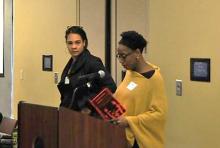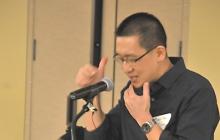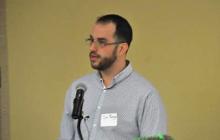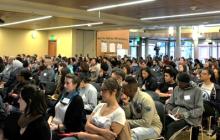Department of History faculty, staff and students played an important part in a one-day teach-in event on the University of Washington campus, entitled "Ferguson and Beyond: Race, State Violence, and Activist Agendas for Social Justice in the 21st Century." History Professor Stephanie Smallwood took a leading role in organizing the event, in conjunction with Professor Ralina Joseph of the Communications Department, and with the assistance of many units and individuals across the university and beyond.
The teach-in, held January 23rd, drew a crowd of two hundred and seventy people from throughout the Seattle area to the university's Ethnic Cultural Center. The aim of the event was to connect past, present and future in order to address the pressing issue of racial and state violence in a constructive way. The morning session, "The Past is Always Present," sought to look back in time and contextualize current events by reference to historical experience. The afternoon portion turned toward the future, by emphasizing the urgent imperative for universal social justice, encouraging student and youth activism as an engine for change, and ending with an open-ended discussion of "The Way Forward."
Professor Smallwood explained that the format grew out of her own experience attending teach-ins as an undergraduate. "In hindsight," she said, "those events turned out to be the rare moments to engage faculty outside the classroom, as real people." A faculty member herself now, Smallwood saw that "we scholars of race, of U.S. history, had something to say, that needed to be said, and wasn't being said."
Along with Professor Smallwood, UW History Professors Moon-Ho Jung and Ileana Rodriguez-Silva, and Professor Dan Berger from UW Bothell (an adjunct professor in the Department of History at UW-Seattle) served as speakers or facilitators for the event. In addition, the attendees included more than a dozen students, staff and faculty from the department.
The important contributions that the study of history offers to present-day policy debates were not lost on organizers or attendees. Seattle Times writer Jerry Large picked up this theme in his January 25th column, noting: "You know the past isn't past when you're invited to a teach-in and the calendar says 2015, not 1965." The teach-in emphasized how contemporary activism can be enriched by an awareness of the historical context. As Professor Berger put it, "Tracing the legacy of slavery and segregation in police violence, as my colleagues did at the teach-in, can help us understand what needs to be changed. Examining how previous reform efforts have failed to address the root cause can help us do better this time."
Although the event's format harkened back to the activism of the 1960s, and one of its goals was to show the relationship between recent events and America's centuries-long history of racial exploitation and inequality, the teach-in also highlighted how the UW History Department and the university are using the technologies and platforms of the 21st century to draw these connections. Organized within a matter of weeks, the workshop was planned, promoted, and moved to a larger venue without the need for a single face-to-face meeting. Since then, technology has also been harnessed to bring the teach-in to an even wider audience: videos and pictures of the event are available online.
For Professor Smallwood, the teach-in idea arose out of a moment of urgency: "We succeeded in creating a space for public engagement, and we were successful because the public is hungry for it." Now she and her colleagues are working to turn that moment into an ongoing dialogue by making it an annual event. However Smallwood sees the most important outcome of the teach-in as the empowerment of a new generation of students. "We saw this as an opportunity to foreground student activists, to support them, to highlight the importance of their voices, and to give them a space to talk about their goals and what is important to them."
This sentiment was particularly evident in the afternoon panel "Student/Youth Activists: Vanguards of 21st Century Social Justice," which participants considered one of the highlights of the day. Presented entirely by student activists themselves, the panel was organized with the aid of Professor Rodriguez-Silva. From the beginning, said Rodriguez-Silva, "we decided the session needed to be about bringing about collective healing and hope through collaboration and action."
The panel highlighted the ongoing work of student activists—work driven by conviction and perseverance, rather than by news cycles or social-media trends. "Many of our students are veterans at community and political mobilization. They know about real and sustainable coalition building," explained Rodgriguez-Silva. "Now it just falls to us to join and grow with them."



